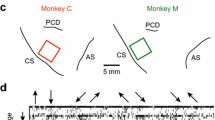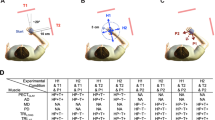Abstract
It is usually assumed that proprioceptive feedback comes to motoneurons too late to contribute to the initial activity of agonist muscles during fast arm movements, leading to the suggestion that this feedback is only efficient in slow movements and postural control. The argument does not take into account that the changes in the motoneuronal membrane potentials and the associated changes in the state of spinal neurons preceding the initial activity of muscles deeply affect, in a forward way, the state of reflex systems by shifting their thresholds, as suggested in the λ model for motor control. As a result, the initial muscle activity emerges with full contribution of these systems so that the effects of reflex delays become negligible. We tested the hypothesis that threshold control of muscle activation may be instrumental in preventing destabilizing effects of proprioceptive delays in spinal and trans-cortical pathways to motoneurons. The analysis was made by recording fast elbow movements (peak velocity ∼300–500°/s) and simulating them in a dynamic model that incorporates the notion of threshold control of intrinsic and reflex muscle properties. The model was robust in reproducing experimental movement patterns (R 2>0.95). It generated stable output despite substantial proprioceptive (up to 100 ms) and electromechanical (40 ms) delays. Stability was thus ensured for delays not only in segmental (about 25–50 ms) but also in trans-cortical loops (50–70 ms). Our study illustrates that a natural physiological process—threshold control—may manifest feed-forward properties hitherto attributed to hypothetical internal neural models.







Similar content being viewed by others
References
Adamovich SV, Levin MF, Feldman AG (1997) Central modifications of reflex parameters may underlie the fastest arm movements. J Neurophysiol 77:1460–1469
Archambault PS, Mihaltchev P, Levin MF, Feldman AG (2005) Basic elements of arm postural control analyzed by unloading. Exp Brain Res 164:225–241
Asatryan DG, Feldman AG (1965) Functional tuning of the nervous system with control of movements or maintenance of a steady posture: I. Mechanographic analysis of the work of the joint on execution of a postural task. Biophysics 10:925–935
Belen’kii VY, Gurfinkel VS, Pal’tsev Y (1967) Elements of control of voluntary movements. Biofizika 10:135–141
Berkinblit MB, Deliagina TG, Orlovsky GN, Feldman AG (1980) Activity of motoneurons during fictitious scratch reflex in the cat. Brain Res 193:427–438
Bhushan N, Shadmehr R (1999) Computational nature of human adaptive control during learning of reaching movements in force fields. Biol Cybern 81:39–60
Blakemore SJ, Goodbody SJ, Wolpert DM (1998) Predicting the consequences of our own actions: the role of sensorimotor context estimation. J Neurosci 18(18):7511–7518
Brown IE, Loeb GE (2000) A reductionist approach to creating and using neuromuscular models. In: Winters JM, Crago PE (eds) Biomechanics and neural control of posture and movement. Springer, Berlin Heidelberg New York, pp 148–163
Burke RE, Rudomin P, Zajac FE III (1976) The effect of activation history on tension production by individual muscle units. Brain Res 109:515–529
Cavanagh PR, Komi PV (1979) Electromechanical delay in human skeletal muscle under concentric and eccentric contractions. Eur J Appl Physiol Occup Physiol 42(3):159–163
Desmedt JE (1983) Size principle of motoneuron recruitment and the calibration of muscle force and speed in man. Adv Neurol 39:227–251
Dubois DM (2001) Computing anticipatory systems. AIP Conf Proc 573XI:706
Dudley GA, Harris RT, Duvoisin MR, Hather BM, Buchanan P (1990) Effect of voluntary vs. artificial activation on the relationship of muscle torque to speed. J Appl Physiol 69(6):2215–2221
Feldman AG (1966) Functional tuning of the nervous system with control of movement or maintenance of a steady posture. II. Controllable parameters of the muscle. Biophysics 11:565–578
Feldman AG (1980) Superposition of motor programs. II. Rapid flexion of forearm in man. Neuroscience 5:91–95
Feldman AG (1986) Once more on the equilibrium-point hypothesis (λ model) for motor control. J Mot Behav 18(1):17–54
Feldman AG (2006) Equilibrium point control (an essay). In: Amir Karniel (ed) Encyclopedic reference of neuroscience. Field: Comput Motor Control (in press)
Feldman AG, Latash ML (2005) Testing hypotheses and the advancement of science: recent attempts to falsify the equilibrium point hypothesis. Exp Brain Res 161:91–103
Feldman AG, Levin MF (1995) The origin and use of positional frames of reference in motor control. Behav Brain Sci 18:723–806
Feldman AG, Orlovsky GN (1972) The influence of different descending systems on the tonic stretch reflex in the cat. Exp Neurol 37:481–494
Flanagan JR, Wing AM (1997) The role of internal models in motion planning and control: evidence from grip force adjustments during movements of hand-held loads. J Neurosci 17:1519–1528
Ghafouri M, Feldman AG (2001) The timing of control signals underlying fast point-to-point arm movements. Exp Brain Res 137:411–423
Gottlieb GL, Corcos Dm, Agarwal CC (1989) Strategies for the control of voluntary movements with one mechanical degree of freedom. Behav Brain Sci 12:189–250
Gribble PL, Ostry DJ (2000) Compensation for loads during arm movements using equilibrium-point control. Exp Brain Res 135:474–482
Gribble PL, Ostry DJ, Sanguineti V, Laboissière R (1998) Are complex control signals required for human arm movements? J Neurophysiol 79:1409–1424
Hill AV (1938) The heat of shortening and the dynamic constants of muscle. Proc R Soc Lond Ser B 126:136–195
Hinder MR, Milner TE (2003) The case for an internal dynamics model versus equilibrium point control in human movement. J Physiol 549:953–963
Jenmalm P, Dahlstedt S, Johansson RS (2000) Visual and tactile information about object-curvature control fingertip forces and grasp kinematics in human dexterous manipulation. J Neurophysiol 84:2984–2997
Kots YM, Zhukov VI (1973) Supraspinal control over segmental centers of antagonist muscles in man. 3. Tuning of spinal reciprocal inhibition system during organization preceding voluntary movement. Neurosci Behav Physiol 16:9–15
Kozhina GV, Person RS, Smetanin BN. (1985) State of motoneurons and the monosynaptic reflex arc before a simple voluntary movement (in Russian). Fiziol Cheloveka 11:606–615
Lestienne F (1979) Effects of inertial load and velocity on the braking process of voluntary limb movements. Exp Brain Res 35(3):407–418
Loeb GE, Brown IE, Cheng EJ (1999) A hierarchical foundation for models of sensorimotor control. Exp Brain Res 126:1–18
Matthews PBC (1959) A study of certain factors influencing the stretch reflex of the decerebrated cat. J Physiol 147:547–564
Miall RC, Weir DJ, Wolpert DM, Stein JF (1993) Is the cerebellum a Smith predictor? J Mot Behav 25:203–216
Nichols TR, Steeves JD (1986) Resetting of resultant stiffness in ankle flexor and extensor muscles in the decerebrated cat. Exp Brain Res 62:401–410
Norman RW, Komi PV (1979) Electromechanical delay in skeletal muscle under normal movement conditions. Acta Physiol Scand 106:241–248
Ostry DJ, Feldman AG (2003) A critical evaluation of the force control hypothesis in motor control. Exp Brain Res 153:275–288
Partridge LD, Benton LA (1981) Muscle the motor. In: Brooks VB (eds) Handbook of physiology, Sect. I: The nervous system, vol II, Motor control part 1. American Physiological Society, Bethesda, pp 43–106
Pierrot-Deseilligny E, Katz R, Hultborn H (1983) Functional organization of recurrent inhibition in man: changes preceding and accompanying voluntary movements. Adv Neurol 39:443–457
Pilon J-F, De Serres SJ, Feldman AG (2005a) Precision grip during arm movement examined in the context of threshold control. In: Progress in motor control V, Pennsylvania (USA), Proceedings
Pilon J-F, De Serres SJ, Feldman AG (2005b) Threshold control of arm movement while holding an objects: no need for invoking internal models. In: 35th neuroscience meeting, Abstracts
Rosen R (1985) Anticipatory systems. Philosophical, mathematical and methodological foundations. Pergamon, New York
Rothwell JC, Traub MM, Marsden D (1982) Automatic and “voluntary” responses compensating for disturbances of human thumb movements. Brain Res 248:33–41
Rothwell JC, Day BL, Berardeli A, Marsden D (1986) Habituation and conditioning of the human long latency stretch reflexes. Exp Brain Res 63:197–204
Shweighofer N, Arbib MA, Kawato M (1998) Role of cerebellum in reaching movements in humans. I. Distributed inverse dynamic control. Eur J Neurosci 10:86–94
St-Onge N, Feldman AG (2004) Referent configuration of the body: a global factor in the control of multiple skeletal muscles. Exp Brain Res 155:291–300
St-Onge N, Adamovich SV, Feldman AG (1997) Control processes underlying elbow flexion movements may be independent of kinematic and electromyographic patterns: experimental study and modelling. Neuroscience 79:295–316
Thomas CK, Johansson RS, Bigland-Ritchie B (1999) Pattern of pulses that maximize force output from single human thenar motor units. J Neurophysiol 82:188–95
Von Holst E, Mittelstaedt H (1950/1973) Daz reafferezprincip. Wechselwirkungen zwischen Zentralnerven-system und Peripherie. Naturwiss 37:467–476. The reafference principle. In: The behavioral physiology of animals and man. The collected papers of Erich von Holst. Martin R (translator) University of Miami Press, Coral Gables, Florida, vol 1, pp 139–173
Wagner H, Blickhan R (1999) Stabilizing function of skeletal muscles: an analytical investigation. J Theor Biol 199:163–179
Weeks DL, Aubert MP, Feldman AG, Levin MF (1996) One-trial adaptation of movement to changes in load. J Neurophysiol 75(1):60–74
Westing SH, Seger JY, Thorstensson A (1990) Effects of electrical stimulation on eccentric and concentric torque–velocity relationships during knee extension in man. Acta Physiol Scand 140:17–22
Witney AG, Goodbody SJ, Wolpert DM (1999) Predictive motor learning of temporal delays. J Neurophysiol 82:2039–2048
Witney AG, Wing A, Thonnard J-L, Smith AM (2004) The cutaneous contribution to adaptive precision grip. Trends Neurosci 27(10):637–643
Zatsiorsky VM, Duarte M (2000) Rambling and trembling in quiet standing. Motor Control 4:185–200
Acknowledgments
Supported by NSERC, CIHR, FQRNT, and IGB (University of Montreal), Canada. We thank Mindy Levin for improving the text.
Author information
Authors and Affiliations
Corresponding author
Rights and permissions
About this article
Cite this article
Pilon, JF., Feldman, A.G. Threshold control of motor actions prevents destabilizing effects of proprioceptive delays. Exp Brain Res 174, 229–239 (2006). https://doi.org/10.1007/s00221-006-0445-3
Received:
Accepted:
Published:
Issue Date:
DOI: https://doi.org/10.1007/s00221-006-0445-3




